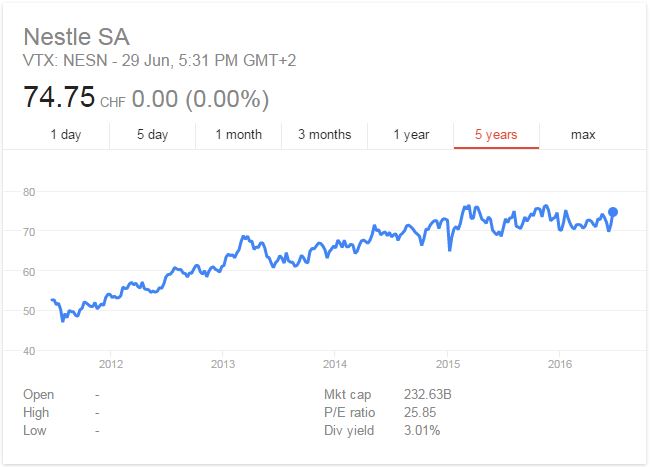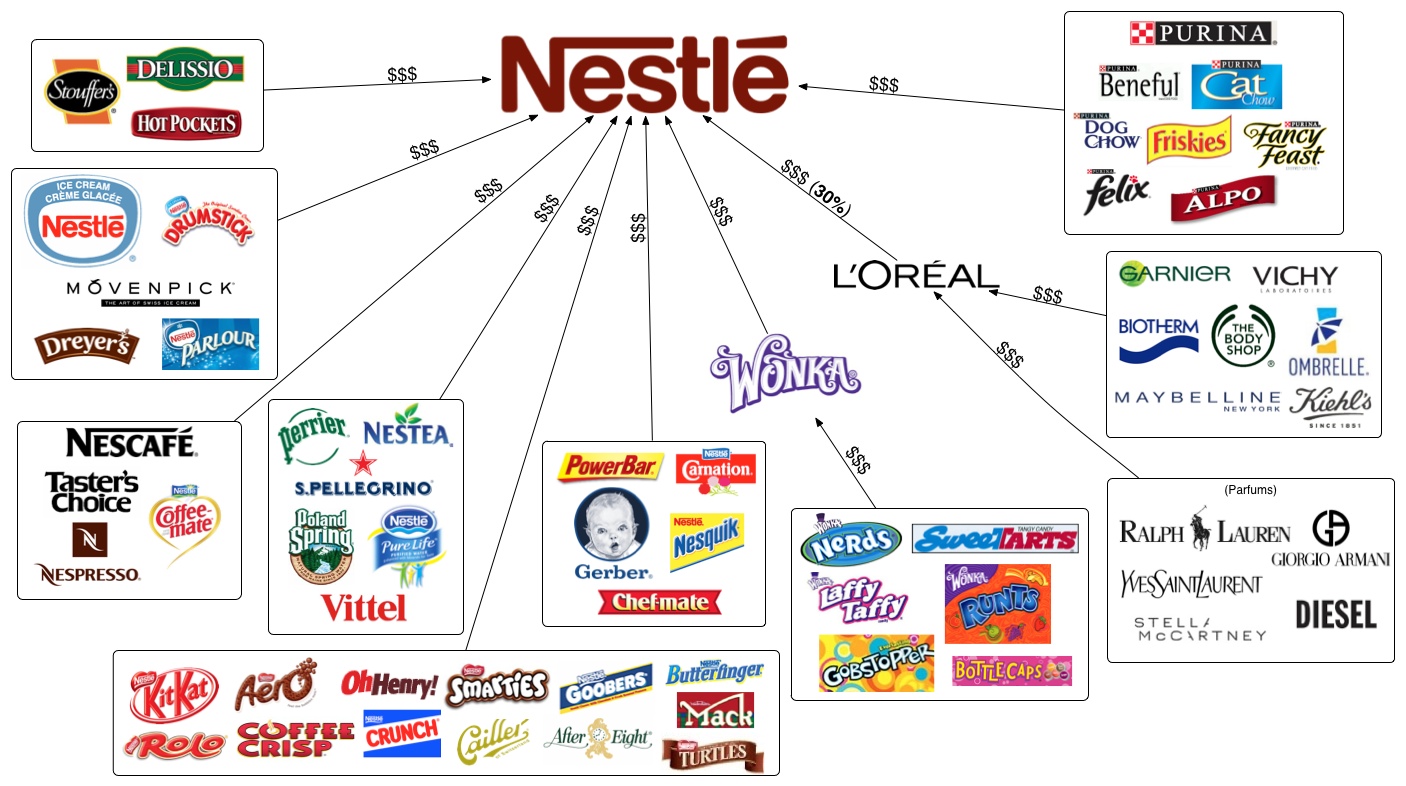Nestlé
 Headquarters: Vevey, Vaud, Switzerland
Headquarters: Vevey, Vaud, Switzerland
Key people: Peter Brabeck-Letmathe (Chairman), Paul Bulcke (CEO) & François-Xavier Roger (CFO)
Currency conversion:
1 Swiss Franc CHF = $1.02 USA
Revenue: CHF 91.6 billion
Operating income: CHF 14.0 billion
Profit: CHF 14.5 billion
Total assets: CHF 133.45 billion
Total equity: Increase CHF 71.88 billion
Number of employees: 339,000
 Products:
Products:
Nestlé’s products include baby food, medical food, bottled water, breakfast cereals, coffee and tea, confectionery, dairy products, ice cream, frozen food, pet foods, and snacks. Twenty-nine of Nestlé’s brands have annual sales of over CHF1 billion including Nespresso, Nescafé, Kit Kat, Smarties, Nesquik, Stouffer’s, Vittel, and Maggi. Nestlé has 447 factories, operates in 194 countries, and employs around 339,000 people. It is one of the main shareholders of L’Oreal, the world’s largest cosmetics company.
SWOT Analysis of Nestle:
Strengths:
1) Product diversity: As of October 2014, the company had 29 operating brands under which 8000 products were being sold in the market. This show the very diversity in the product line which yield a great strength for nestle.
2) Distribution channels: Nestle is successfully operating in more than 100 countries which gives a real strength to its distribution channel. Including direct and indirect channels, it has operations in 197 countries.
3) Nestlé’s R&D: Nestle has a strongest research and product designing teams with great capabilities. They introduce new products through the year, which strengthen Nestlé’s competitive advantage.
4) Brand value and Reputation: In 2013, Nestle became one of the top ten reputable companies in the world in the annual. Nestle numbered 43th position in the World’s Most Valuable Brands.
Weaknesses:
1) Less ability to provide good foods consistently: As consumers always look for good tasting and healthy foods, a company should consistently provide healthy foods. Nestle is often blamed for many products due to poor supplies. It is hurting the image of Nestle which is a great weakness.
2)Criticism: Nestle has been criticized many times over different issues including child labour, horse meat scandal, which make it less trust worthy.
Opportunities:
1) Demand for healthier food products: Great intensity of buying and consuming quality foods is increasing among people. Nestle frequently tries to provide quality foods to its consumers.
2) As global purchasing power increases, people spend more and more on processed foods.
Threats:
1) New laws: Governments will bring in laws which will make it more difficult to use fertilizers and pesticides. People with more purchasing power will shift towards organically produced local
2) Legal penalties: Nestle is open to legal penalties for false marketing and leading to worsening public health.
3) Raising Prices of Raw materials: With the growth of the economy of the world, the price of raw materials is increasing which may harm its competitive price in future.
Controversies:
- Maggi noodles: In May 2015, Food Safety Regulators from the Uttar Pradesh, India found that samples of Nestlé's leading noodles Maggi had up to 17 times beyond permissible safe limits of lead in addition to monosodium glutamate.
- 2008 Chinese milk scandal: In late September 2008, the Hong Kong government found melamine in a Chinese-made Nestlé milk product. Six infants died from kidney damage, and a further 860 babies were hospitalised. The Dairy Farm milk was made by Nestlé's division in the Chinese coastal city Qingdao.
- Cookie dough: In June 2009, an outbreak of E. coli was linked to Nestlé's refrigerated cookie dough originating in a plant in Danville, Virginia. In the US, it caused sickness in more than 50 people in 30 states, half of whom required hospitalisation. Following the outbreak, Nestlé voluntarily recalled 30,000 cases of the cookie dough.
- Nestlé boycott: A boycott was launched in the United States on 7 July 1977, against the Swiss-based Nestlé Corporation. It spread in the United States, and expanded into Europe in the early 1980s. It was prompted by concern about Nestlé's "aggressive marketing" of breast milk substitutes, particularly in less economically developed countries (LEDCs), largely among the poor. The boycott was officially suspended in the U.S. in 1984, after Nestlé agreed to follow an international marketing code endorsed by the WHO.
- Ethiopian debt: In 2002, Nestlé demanded that the nation of Ethiopia repay US$6 million of debt to the company. Ethiopia was suffering a severe famine at the time. Nestlé backed down from its demand after more than 8,500 people complained via e-mail to the company about its treatment of the Ethiopian government. The company agreed to re-invest any money it received from Ethiopia back into the country.
- Chocolate price fixing: In Canada, the Competition Bureau raided the offices of Nestlé Canada (along with those of Hershey Canada Inc. and Mars Canada Inc) in 2007 to investigate the matter of price fixing of chocolates. It is alleged that executives with Nestlé, the maker of KitKat, Coffee Crisp and Big Turk, colluded with competitors in Canada to inflate prices.
Sources:
http://www.gotabout.info/swot-analysis-of-nestle/
https://en.wikipedia.org/wiki/Nestl%C3%A9
http://static.tumblr.com/967a0c04482644d12b3a3e2f49c23da5/op78yd4/RjQnr5ccn/tumblr_static_2a75n5b3q9s0g4ogks0sok4wc.jpg